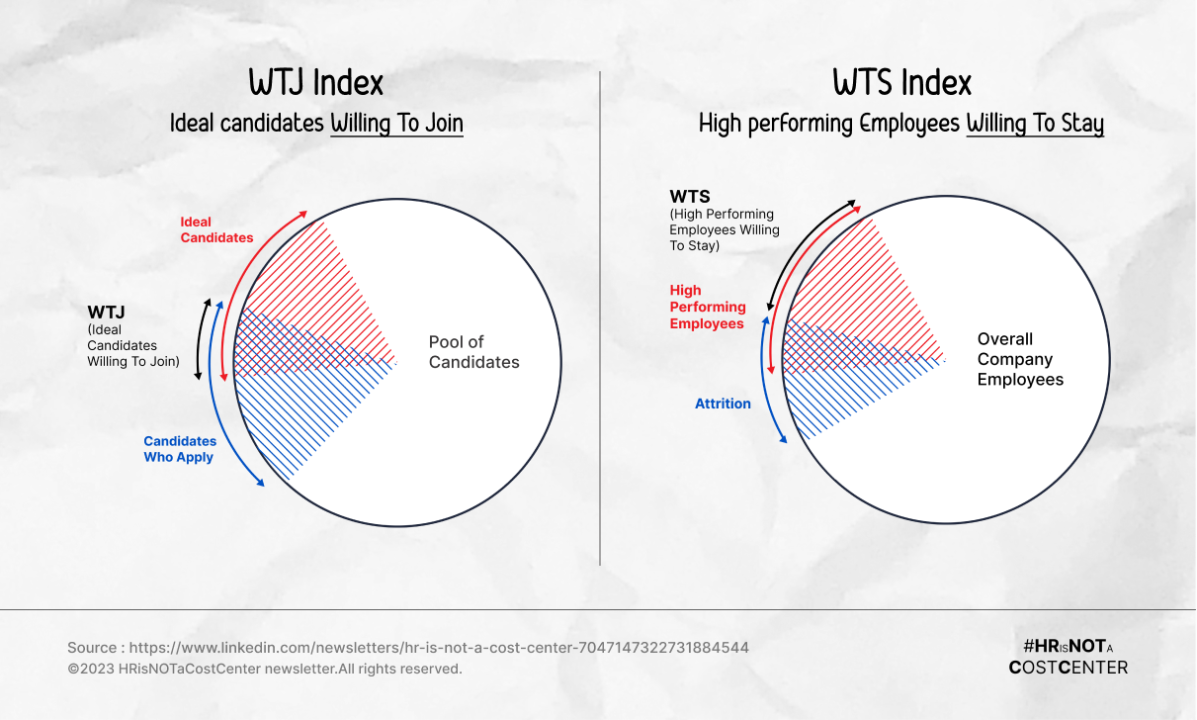
Resources > Manu’s Blog > Role of HR Leaders in building an Iconic Brand
Role of HR Leaders in building an Iconic Brand
Founder & CEO – Rolling Arrays

Originally Published on LinkedIn
Introduction :
In this article, we will explore two vital metrics that HR leaders should prioritise: the WTJ (Willingness to Join) index and the WTS (Willingness to Stay) index. From my perspective, these metrics serve as a differentiating strategy to build a high-performing team, positioning an organization far ahead of its competition. Let’s delve into each index and understand their significance for HR leaders.
Understanding the WTJ Index: Amongst all “available candidates”, WTJ Index is the % of “ideal candidates” who prefer to join your company at same or less salary package when they have more than 1 Job offers.
Let’s understand this with a simple example
Eg : If you are hiring for a graduate program and your primary requirement is engineering graduates. All engineering graduates completing degree in that year will make the total “available candidates” pool. Let’s say this number is 1,000.
Based on the historical performance of graduate trainees in your company, the hiring managers prefer candidates from the top 3 Universities, so Engineering graduates completing degree from the top 3 Universities in that year will become your “ideal candidate” pool. Let’s say this number is 250.
Amongst the ideal candidate pool of 250, let’s say 50 candidates prefer to join your graduate program even if they have similar offers from other companies.
Based on above example, your organization’s index is 50/250 = 20%
Idea is to figure out a consistent strategy so that your organization is able to increase the WTJ index year on year to hire the best from the market and build a high performing team.
Why Focus on WTJ Index ?
As an HR leader, one thing we must drive and measure is if the best candidates out there are willing to join. If not, the second best will get hired and that in the long run will eventually make your firm second best to your competition. so HR leaders must constantly endeavor to drive up the WTJ so much so that amongst all competitors, your firm is the first choice for all ideal candidates. Here WTJ among the Ideal candidates is the key as that then becomes the centrepiece of the “attract” strategy instead of targeting all candidates which may include non-ideal candidates and distract the focus or reduce the productivity of the efforts to drive up the WTJ.
Understanding the WTS Index : Amongst all “current employees”, WTS Index is the retention % of “High Performing” Employees who prefer to stay due to consistently high professional & financial growth and a positive culture.
Let’s understand this with a simple example :
Your organization has 1000 employees. Out of these employees, based on the last year’s performance review cycle, 300 employee’s performance rating was 4 or more (on a scale of 0-5). Out of these 300 high performers, 15 employees left the organization.
Based on above example, index of your organization is 285/300 = 95%
Let’s relate ‘WTS index’ with ‘overall attrition %’ and understand why it is important to focus on WTS index and NOT on overall attrition %
Out of the 1000 employees, 150 left the organization. That makes the overall attrition % = 15% (150/1000)
Out of the 150 employees who left, key is to find out how many were high performers (which is 15 as per the example scenario) and why they left, and then double down to solve those reasons so that your organization has a high WTS Index (i.e. min attrition % of high performers).
Why Focus on WTS Index ?
It is important to understand that the retention strategy which is bulk of your entire HR Transformation strategy should not be diluted by focusing on reasons of all leaving employees. Because by design, in a high performing organization, the churn of average or below average performers will be higher than the industry benchmark and ‘overall attrition %‘ may be a misleading benchmark to consider and solve for.
For the employees whose rating is below 4, instead of focusing on their reasons for leaving, we should instead focus on reasons of their non-performance or average performance and build a framework to improve that so that maximum employees achieve a rating of 4 and above.
(You can refer to the reasons of high performance by an employee in my previous article)
Conclusion :
Led by an ace HR Leader and whole heartedly supported by the top management including the CEO, a business can persuade the best talent out there to apply, a business can build an assessment framework to then hire the best from the already willing ideal talent pool thereby building a high WTJ index;
And then subsequently building a framework to assess their performance to find out the top performers and then build a culture to retain the top talent thereby building a high WTS index;
The top talent that gets hired, and such top talent when retained over a period of time delivers a value that is par excellence which puts your business way ahead of your competition; thereby building a famous brand which then everyone wants to be a part of whether they are your employees or your customers. This then eventually makes an already known brand ‘Iconic’.
About Manu Khetan
Manu, Founder and CEO of Rolling Arrays, a global HR technology leader, brings two decades of expertise to redefine HR practices. Passionate about pioneering HR automation and nurturing talent, Manu advocates for a customer-first and employee-first approach, prioritizing value creation. Beyond the boardroom, he is a dedicated family man, a skilled pianist, and an advocate for empowering the next generation of entrepreneurs. Join Manu on the transformative journey where HR emerges as a dynamic force for positive change in the business world.




Share with your network
Get updates in your inbox